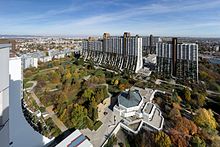Alterlaa
48°09′08″N 16°18′47″E / 48.15222°N 16.31306°E




Alterlaa (Austrian German pronunciation: [altˈɛʁlaː]) is a residential development in Vienna, Austria, designed by Harry Glück. Built from 1975 to 1986, it features distinctive set-backs on its lower floors and large terraces with planting troughs for use by residents. It houses around 9,000 people in 3,200 apartments.
Design
[edit]The Alterlaa complex was designed by Austrian architect Harry Glück as income-restricted housing.[1] Located to the south-west of central Vienna the site occupies 24 hectares (59 acres) and is one of the largest residential complexes in Austria.[2] Planning for the complex began in 1972, as part of a pilot scheme to expand Vienna with satellite towns.[3][2] Glück took inspiration from Le Corbusier's 1930s Ville Radieuse and the 1920s designs for terrassenhaus by Adolf Loos and Oskar Strnad.[4][5] Glück had incorporated a similar set-back profile and garden terrace in his 1971 design of a block for the Junge Generation housing association.[5]
Glück's design for Alterlaa features blocks of housing structures arranged into three north-south lines. The blocks have prominent set-back terraces on the lowest 12 storeys, with a further 10 to 15 vertical-sided storeys above.[6] The construction was carried out by the GESIBA municipal cooperative agency from 1975 to 1986.[1][3] Glück's intention was to create a "city within a city".[2] The blocks have been described as similar to ziggurats and reminiscent of works carried out by the American Public Works Administration in the New Deal era.[5] The designs have been criticised for having an American influence but the complex has also been cited as an example of how social housing should be built.[7] Alterlaa was reported in 2008 as having the highest tenant satisfaction rating in Vienna.[8]
Features
[edit]The complex provides 3,200 apartments and, as of 2022[update], about 9,000 people lived there. The average apartment size is 74.5 square metres (802 sq ft) with 65 per cent of the apartments having three or more rooms.[2] Each terraced apartment has a large balcony with a 4 m2 (43 sq ft) trough planter in front of it. Residents plant trees and flowers in the planter, which they are responsible for maintaining.[1]
The site has seven outdoor rooftop swimming pools, seven indoor swimming pools, twenty saunas, two indoor tennis centres and four badminton courts.[7] There is also a church, local television station, shopping centre, newspaper office, medical facility (with at least 12 doctors), kindergartens, schools, library, playgrounds and a park.[7][2][9] The entrance foyers of each building host large works of art.[6] There are 3,400 parking spaces for residents, and the complex is near the Alterlaa station on the Vienna U-Bahn.[2][9]
References
[edit]- ^ a b c Ludwig, Ferdinand; Schönle, Daniel (19 December 2022). Growing Architecture: How to Design and Build with Trees. Birkhäuser. p. 103. ISBN 978-3-0356-0339-2.
- ^ a b c d e f Johnson, Jeffrey; Brazier, Cressica; Lam, Tat (19 January 2022). The China Lab Guide to Megablock Urbanisms. Actar D, Inc. p. 143. ISBN 978-1-63840-829-1.
- ^ a b Glendinning, Miles (25 March 2021). Mass Housing: Modern Architecture and State Power – a Global History. Bloomsbury Publishing. p. 223. ISBN 978-1-4742-2929-6.
- ^ Lopes, Joao Teixeira; Hutchison, Ray (17 November 2016). Public Spaces: Times of Crisis and Change. Emerald Group Publishing. p. 238. ISBN 978-1-78635-463-1.
- ^ a b c Swenarton, Mark; Avermaete, Tom; Heuvel, Dirk van den (15 September 2014). Architecture and the Welfare State. Routledge. p. 43. ISBN 978-1-317-66190-0.
- ^ a b Holan, Eric; Sarne, Berta (1984). Colourful Vienna. Schroll. p. 100. ISBN 978-3-7031-0550-0.
- ^ a b c Glauser, Andrea (12 March 2020). Vertical Europe: The Sociology of High-rise Construction. Campus Verlag. p. 131. ISBN 978-3-593-51016-3.
- ^ Heuvel, Dirk van den; Mesman, Maarten (2008). The Challenge of Change: Dealing with the Legacy of the Modern Movement. IOS Press. p. 406. ISBN 978-1-58603-917-2.
- ^ a b Beanland, Christopher (7 August 2020). Lido: A dip into outdoor swimming pools: the history, design and people behind them. Batsford Books. p. 60. ISBN 978-1-84994-678-0.
